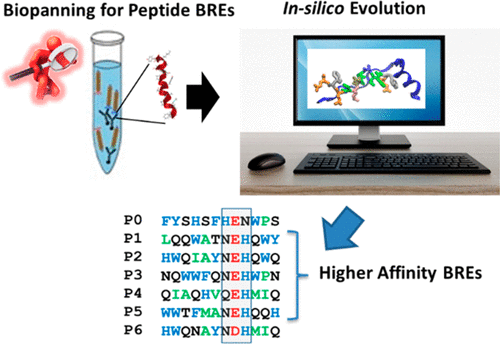Our official English website, www.x-mol.net, welcomes your feedback! (Note: you will need to create a separate account there.)
Advancing Peptide-Based Biorecognition Elements for Biosensors Using in-Silico Evolution
ACS Sensors ( IF 8.9 ) Pub Date : 2018-05-09 00:00:00 , DOI: 10.1021/acssensors.8b00159 Xingqing Xiao 1 , Zhifeng Kuang , Joseph M. Slocik , Sirimuvva Tadepalli 2 , Michael Brothers , Steve Kim , Peter A. Mirau , Claire Butkus , Barry L. Farmer , Srikanth Singamaneni 2 , Carol K. Hall 1 , Rajesh R. Naik
ACS Sensors ( IF 8.9 ) Pub Date : 2018-05-09 00:00:00 , DOI: 10.1021/acssensors.8b00159 Xingqing Xiao 1 , Zhifeng Kuang , Joseph M. Slocik , Sirimuvva Tadepalli 2 , Michael Brothers , Steve Kim , Peter A. Mirau , Claire Butkus , Barry L. Farmer , Srikanth Singamaneni 2 , Carol K. Hall 1 , Rajesh R. Naik
Affiliation

|
Sensors for human health and performance monitoring require biological recognition elements (BREs) at device interfaces for the detection of key molecular biomarkers that are measurable biological state indicators. BREs, including peptides, antibodies, and nucleic acids, bind to biomarkers in the vicinity of the sensor surface to create a signal proportional to the biomarker concentration. The discovery of BREs with the required sensitivity and selectivity to bind biomarkers at low concentrations remains a fundamental challenge. In this study, we describe an in-silico approach to evolve higher sensitivity peptide-based BREs for the detection of cardiac event marker protein troponin I (cTnI) from a previously identified BRE as the parental affinity peptide. The P2 affinity peptide, evolved using our in-silico method, was found to have ∼16-fold higher affinity compared to the parent BRE and ∼10 fM (0.23 pg/mL) limit of detection. The approach described here can be applied towards designing BREs for other biomarkers for human health monitoring.
中文翻译:

使用in-silic进化推进基于肽的生物传感器的生物识别元件。
用于人类健康和性能监控的传感器需要在设备接口处使用生物识别元件(BRE),以检测可测量的生物状态指标的关键分子生物标记。BRE(包括肽,抗体和核酸)与传感器表面附近的生物标记物结合,产生与生物标记物浓度成比例的信号。发现具有在低浓度下结合生物标志物所需的敏感性和选择性的BRE仍然是一项基本挑战。在这项研究中,我们描述了一种计算机内方法,可进化出基于高灵敏度肽的BRE,以从先前鉴定为父母亲和力肽的BRE中检测心脏事件标记蛋白肌钙蛋白I(cTnI)。使用我们开发的P2亲和力肽在硅胶法中,与亲本BRE相比,亲和力高约16倍,检测限约10 fM(0.23 pg / mL)。此处描述的方法可以应用于为其他生物标记物设计BRE,以进行人体健康监测。
更新日期:2018-05-09
中文翻译:

使用in-silic进化推进基于肽的生物传感器的生物识别元件。
用于人类健康和性能监控的传感器需要在设备接口处使用生物识别元件(BRE),以检测可测量的生物状态指标的关键分子生物标记。BRE(包括肽,抗体和核酸)与传感器表面附近的生物标记物结合,产生与生物标记物浓度成比例的信号。发现具有在低浓度下结合生物标志物所需的敏感性和选择性的BRE仍然是一项基本挑战。在这项研究中,我们描述了一种计算机内方法,可进化出基于高灵敏度肽的BRE,以从先前鉴定为父母亲和力肽的BRE中检测心脏事件标记蛋白肌钙蛋白I(cTnI)。使用我们开发的P2亲和力肽在硅胶法中,与亲本BRE相比,亲和力高约16倍,检测限约10 fM(0.23 pg / mL)。此处描述的方法可以应用于为其他生物标记物设计BRE,以进行人体健康监测。


























 京公网安备 11010802027423号
京公网安备 11010802027423号